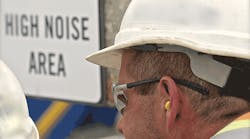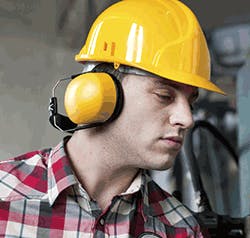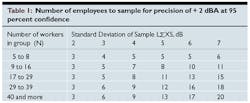To maintain compliance with OSHA 29 CFR 1910.95 (Hearing Conservation), monitoring must be conducted to determine areas of high noise levels and the presence of high noise sources. The effort is to reduce the potential that personnel have permanent damage to their hearing from noise induced hearing loss.
Exposures to excessive noise levels may require personnel to be part of a hearing conservation program (HCP). Approximately 17 percent, or 26 million, adults (age 20-69) have permanent damage to their hearing from exposure to excessive noise.
As part of a medical surveillance program, personnel have been placed on the hearing conservation program based solely on their job classification and knowledge of the type of work the employees perform. Most of these employees are not assigned to a certain location because their work requires them to conduct tasks in many areas of the facility. A review of the medical surveillance questionnaire would be made and based on past history, job classification and knowledge of the worksite, a decision would be made to determine inclusion into the hearing conservation program.
Rise of Noise Dosimetry
Over a period of three to four years, an effort has been performed to collect noise dosimetry data on workers in various occupations. Much of this has been conducted in conjunction with employees receiving a threshold shift from a recent audio exam. Dosimetry data is collected as guidance to accompany the medical surveillance in order to aid the physician during the employee's 30-day follow-up exam.
When an employee has a potential threshold shift, the industrial hygiene group is notified. A consult with the employee is performed to gather information on any changes to work tasks, possible exposures to high noise levels (at work or away), use of high noise equipment, and use of hearing protection. At this time, the employee is provided with a calibrated noise dosimeter, which is placed at the lapel level on the person. Full day samples are collected, downloaded and analyzed using software supplied by the dosimeter manufacturer.
Employees are separated into similar exposure groups (SEGs) based on their occupational position and title. It is noted what their duties consist of, whether they work in documented high noise areas, and if they are required to work with high noise equipment. This information is collected during the initial consult after it has been determined they have a threshold shift. Once their dosimetry data is analyzed, the industrial hygienist determines the average and standard deviation for each exposure group. By using the group population and standard deviation of the sample group, an assessment is made to determine if a statistically sound number of samples were taken for each group. If there is a need, additional noise dosimetry samples are collected to meet the minimum number of samples to have a 95 percent confidence interval with a + 2 dBA.
The pictured table is an example of this type of assessment for a group of employees. At this site, for the group of electricians (~30), 13 dosimetry samples were collected with an average dBA of 74.6 and standard deviation of 4.13. Based on this guidance, the minimum number of samples to be collected was met.
As opposed to using the eight hour time weighted average (TWA) of 90 dBA promulgated by OSHA, the adopted eight hour (TWA) used at this facility is 85 dBA. This level is used by the American Conference of Governmental Industrial Hygienists and the National Institute of Occupational Safety and Health as the eight hour limit. A level of 82 dBA is used as the action level and decision for inclusion into the hearing conservation program. Based on the average dBA time weighted average (TWA) from the dosimetry collected for each occupational group, and considering the tasks performed (in particular the use of high noise equipment), a determination is made to include or exclude each group of personnel in the hearing conservation program.
The approach to defining SEGs may be accomplished through observation of occupational work tasks along with exposure monitoring. This assessment strategy has been useful when well-defined groups are developed and when log-normal, statistically strong dosimetry data is generated for individuals within the groups.
When applying this exposure assessment strategy, for the basis of program inclusion or exclusion, excellent coordination is a must from supervisory/management, safety department, industrial hygiene and medical. Prior to this approach, a conservative stance was taken as personnel were placed on the hearing conservation program based on job classification alone with input from the employee on working in high noise areas. With applicable information from supervisors on actual job tasks requirements, along with training, coordination and exposure monitoring from industrial hygiene and safety, analysis of the findings has provided the proper means for assessing personnel for inclusion into an HCP.
With a sufficient quantity of noise dosimetry data collected for each exposure group, better decisions to determine HCP inclusion or exclusion may be accomplished. Even though some groups may have personnel with an average dosimetry TWA less than the action level, the decision may be made to leave some SEGs in the hearing conservation program. This conservative approach would be applied to those non-routine situations when a statistically greater opportunity exists for people in those groups to be exposed to high noise operations based on the tasks they perform, the length of exposure time and noise levels generated. Good sound judgment must be applied from an industrial hygiene and safety standpoint when assessing these situations to assure proper decisions are made when including people on the HCP.
Gregory Smith, MS, CIH, CSP is a Senior Industrial Hygienist with more than 20 years of experience in the Environmental Health group at NASA/Marshall Space Flight Center in Huntsville, AL. Smith is a graduate of the University of North Alabama (BS Industrial Hygiene/Chemistry) and University of Findlay (MS Environmental, Safety & Health Management).


